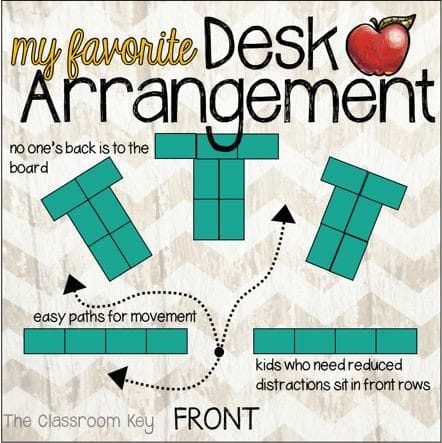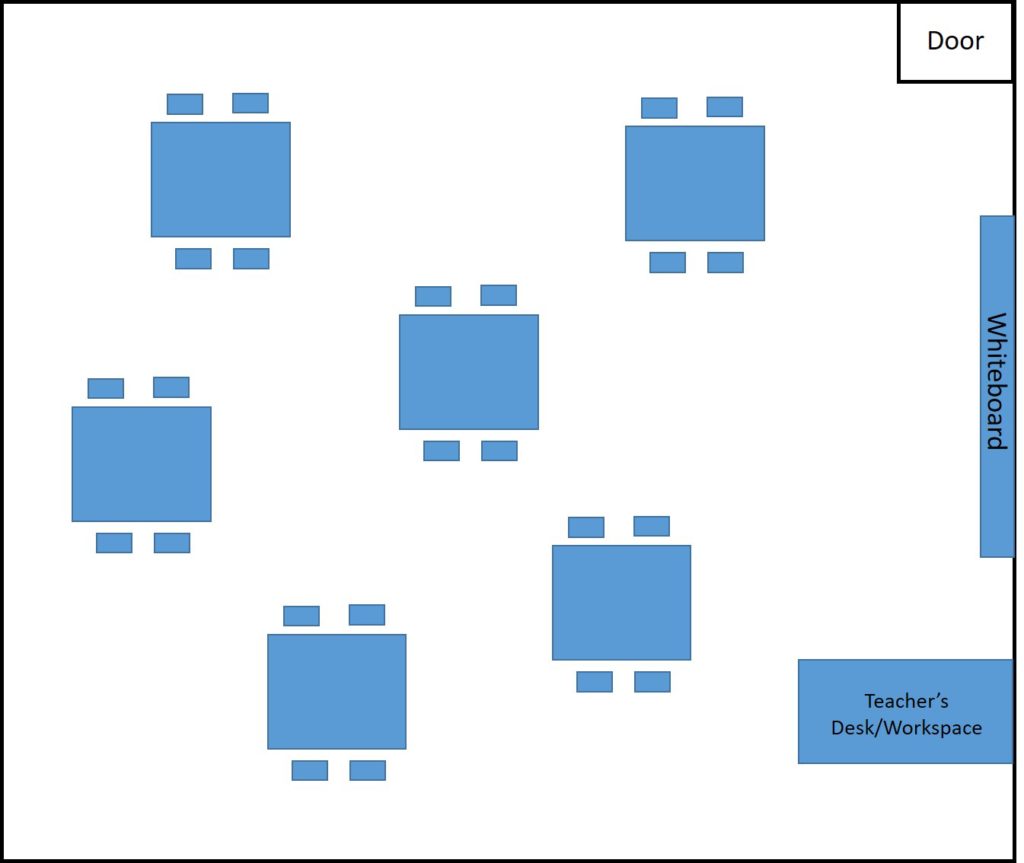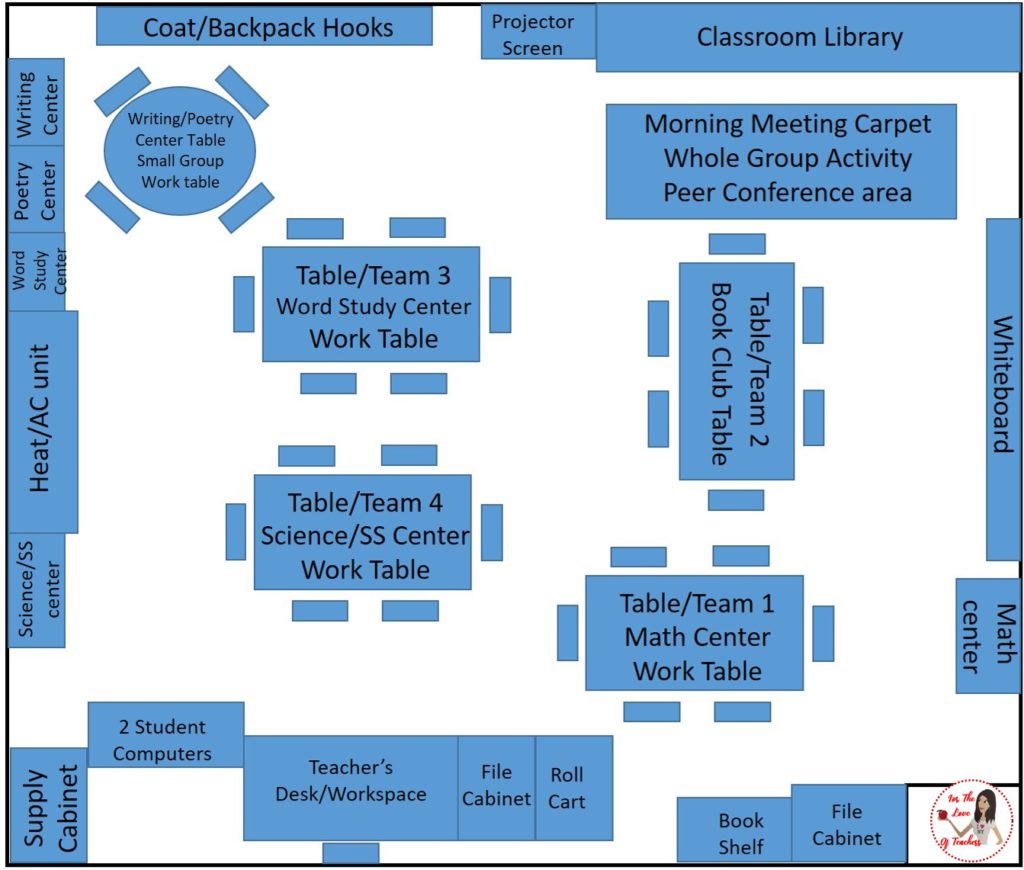
As a teacher at any grade level, classroom management is key to having an environment conducive to teaching and learning. As a Thoughtful Teacher transformational coach, looking at the seating plan is the first focused strategy. Why? A poor seating plan with the wrong arrangement and combinations of students can break your year.
Seating Arrangement
Classrooms come in many shapes and sizes, as do the number of students in each class. Try strategically thinking about how the seats should be arranged in the physical space to meet the needs of the many learning styles of students. The seating arrangement should fit the teacher’s instructional style as well. Keeping both instructional and learning styles in mind, a good seating plan should be conducive to multiple types of work: independent work, partner work, and group work.
I recently was in a high school classroom of 24 students that did this well. Her students were grouped into 6 groups of four to work independently, with face or shoulder partners, or in a group of 4.
In my elementary classroom, I had students grouped into 4 groups of 6. Most of the time I had my students work in their trios (groups of 3) which worked very well. They also were able to work well independently or as a larger group of 6 when needed.
I came across this seating arrangement posted on social media. This got my wheels turning! I liked it because all the students were facing front and there was an option for students to sit in a row if needed. I gave a survey to my students to ask them where they would rather sit, in a group or a row. Choice is powerful! You’d be surprised how many students chose to sit in a row. However, it’s up to the teacher’s discretion to seat students with whom they would work well in a group. Student combinations are key to a classroom environment that is good for both teaching and learning.

I recommend that teachers try out a few seating arrangements to see what best fits. Try a U shape or an M shape. It’s okay to change the seating arrangements throughout the school year. Surprise your students! You may even be surprised by how well they work in a variety of seating arrangements. Plus, students have more opportunities to connect and build relationships with other students that they may not have had the opportunity to do so if the seating arrangement was the same all year.
Student Combinations
At the very beginning of the school year, teachers get their student roster(s), and most times they do not know their students. It takes time for teachers to learn the behaviors of individual students and how they interact with each other. And even if you may have the greatest seating arrangement, the student combinations are key in making the seating arrangement effective. You have all types of students: the chatterboxes, the ones that get easily distracted, the ones that can’t sit still, the ones who need all kinds of attention, some that may need to be closer to the teacher, or even some that may need to be seated independently on an “island” of their own. Whatever the case, it’s really important that the teacher gets to know their students and then seats them where they can be the most successful.
At the very start of the school year, I assign my students seats. I do my best to mix them up and let my students know that their seats are temporary. After getting to know my students socially and academically, I make some moves. I like to give my students a seating survey to help me know where they think they can do their best learning. I give this survey to them after a couple of weeks of school after they get to know one another and adjust to the classroom setting. Get a copy of my seating survey here.
I know some teachers, especially in high school, who let their students choose their own seats. Some classes can handle this, while other classes can’t. Getting to know your students will help you determine what’s a good fit. Even when seats are assigned, I find that letting students choose who they want to work with during group projects or class discussions is a good option. Some students just work better when they know who they’re working with and are comfortable with the students in the group. Giving them this choice works! Also, I see many teachers providing different flexible seating options, like high tables, low tables, stools, beanbag chairs, pillows, and desks/tables, to meet the needs of their students. That is fantastic!
So when you find the right seating arrangement and the right student combinations, you have yourself a winning seating plan. One that will maximize teaching and learning in your classroom.
Do you have a winning seating plan?
If you think that Thoughtful Teacher is for you because you need or want support in classroom management then reach out to your admin about the benefits of Thoughtful Teacher. Don’t be afraid to ask for support or to educate them! For more information visit www.thoughtfulteacher.org. If you have any questions, you can contact info@thoughtfulteacher.org.
Follow me to be notified when new resources are uploaded to the Shop and join the email list to receive the latest and greatest updates, posts, and some awesome freebies!!
If you like it, then pin it!



Christine Weis is a passionate educator, classroom management coach, wife, and mom of two busy boys. She enjoys teaching, writing, and creating resources for teachers.






I’ll be sure to pass this post along to my teacher friends! I can only imagine a seating arrangement is important.
Great…thank you for sharing! Thanks for reading!
Christine at For The Love of Teachers
I am sharing this with all the teachers I know. I am sure this is extremely helpful and a great way to start the school year.
Great…thank you for sharing! Thanks for reading!
Christine at For The Love of Teachers
What a great post, I never knew what kind of thought or strategy went into classroom seating, but it all makes sense now. My teachers usually just put us all in alphabetical order, which I guess made it so they didn’t have to think about it. But your points bring up some fantastic reasons to plan for a successful teaching strategy for teacher & student, and student & student. Thanks so much for sharing your thoughts.
Thank you for your thoughtful comment. Who knew so much went into a seating plan, right?! Thanks for reading!
Christine at For The Love of Teachers
Wow! This is so thoughtful and innovative. I never knew a seating plan can make such a huge difference. But it makes perfect sense now. I’ll be sharing this post with my teacher friends. Very helpful!
Thanks so much! Please do share! I hope it helps many teachers. Thanks for reading!
Christine at For The Love of Teachers
Having a seating plan is so important! My biggest “seating chart” challenge when I was teaching was figuring out how to arrange the students when there are many students in one class who are easily distracted. Do you have any advice for teachers with especially difficult classes?
I have had some difficult classes where the students were either very chatty no matter where they sat, distracted easily and/or could not work with others. Looking at and changing student combinations was so important. I had to mix them up regularly to change the dynamics. I’ve seen difficult classes put into rows, one seat apart, where there was space in between each student. I have also seen teachers seat students that were easily distracted individually on an “island” by themselves and rotate kids on and off these “islands.” These students were also seated closer to the teacher. Rearranging and changing combinations is important to do more often in difficult classes but in some cases with some classes, no matter how many times you make changes, it doesn’t help and it could sometimes hurt the situation. Not an easy fix. Great question! Thanks so much for reading!
Christine at For The Love of Teachers
I like that picture of the classroom you posted as well. I have 20 children in a room and trapezoid tables. 5 to a hexagon. it seems to work this year so far, but I will need to change some seats soon.
Thank you! Oh I like the idea of a hexagon shape. I bet that works well too. You’ll know who you need to change soon. It doesn’t take long. 😉 Thanks for reading!
Christine at For The Love of Teachers
Oh Wow! I never thought that the seating made such a big difference … But it makes so much sense!! Great post!
It really does! It’s all the little things that make the biggest difference. Thanks for reading!
Christine at For The Love of Teachers
This is a very helpful post for teachers.
I remember how teachers used to change our seating plans at regular intervals. Makes lot of sense now.
Thank you! Sometimes the seating plan is overlooked so I think this is important to consider at the beginning of the school year and monitor throughout. Thanks for reading!
Christine at For The Love of Teachers
I bet this is so important to the learning process. Getting it just right has to be tricky.
Yes…getting it right is very tricky. Some years with the group of students I have, it can be VERY tricky and I can’t get it right all year. Other years its a breeze. It all depends on your students. Thanks for reading!
Christine at For The Love of Teachers
seating plans in classrooms definitely make a difference. while i am not a teacher, as a parent whose kids do make a mention every time they move seats, i understand the planning that will go into it
Now as a parent you understand that their is a method behind the “madness” of seat changing. So much thought goes into it so all students can be successful. Thanks for reading!
Christine at For The Love of Teachers
I can see how a seating plan is crucial to classroom success. When I was in school, teachers weren’t generally picking about seating.
I wonder with class sizes becoming larger there may be a need to focus on it more.(?) Thanks for reading!
Christine at For The Love of Teachers
Wow, it is good to see this really. I did not know about the seating plans and it makes perfect sense. Great management of students.
Thank you! Classroom management at its best. 😉 Thanks for reading!
Christine at For The Love of Teachers
I didn’t know that a seating chart was an exact science. I always wonder why teachers did their seating the way they did.
Interesting right!? It’s always a good idea to look at arrangement and students combinations so all students are successful. And changing it up is always a good thing. Thanks for reading!
Christine at For The Love of Teachers
I used to teach middle school and seating charts were AWFUL to make! knowing what would worst for the kids learning environment was tricky! Thanks for sharing these tips! So helpful! xo – Kam
I bet they were. I’m finding it to be critical in those upper grades though. Thanks for reading!
Christine at For The Love of Teachers
This is an interesting post. I think that seating arrangements can and DO make a difference in how well students learn from their teachers. I like that you change the seating arrangements when you get to know the students better and seat them where they will learn best.
Thank you! Changing it up is a good idea, especially after really getting to know your students and then again after the winter break. Or when they are feeling just a little too comfortable. 😉 Thanks for reading!
Christine at For The Love of Teachers